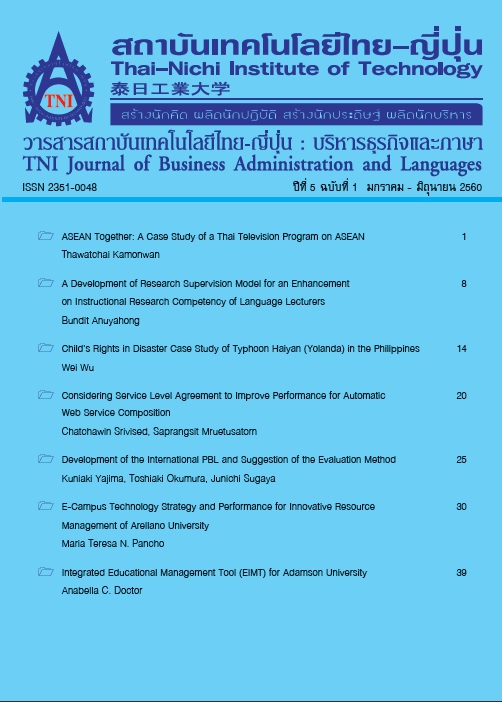Speech2Spell: A Voice-Enabled Spell-Out Game using Voice Recognition Algorithm
Main Article Content
บทคัดย่อ
Speech2Spell: A Voice-Enabled Spell-Out Game Using Voice Recognition Algorithm using Android platform is a mobile game using voice recognition. Voice recognition are used in security reasons to protect or secure one’s property, some are used in voice command machines like televisions, lights, air conditioners and other appliances even in small devices help the users in asking directions and many other things that you didn’t know it can be done by voice recognition. The game speech2spell is a voice recognition game that simply recognizes all single word that is being spoken by the user, the game is played only by a single player; also the game must be played at a quiet environment or user can also use their headphone to limit the noise that has been absorbed or heard by the mobile. The game can help users to improve their knowledge in speaking the right word. The game has a custom mode setting for the user. On custom mode game, the user can take a picture on the object and can be used in game system. The captured images taken from the custom mode is only exclusive at the custom mode. The game also has classic mode, it has a default images that flash on the screen of the mobile for the user can guess what the system shows.
Article Details
นโยบายการรับบทความ
กองบรรณาธิการวารสารสถาบันเทคโนโลยีไทย-ญี่ปุ่น มีความยินดีรับบทความจากอาจารย์ นักศึกษา และผู้ทรงคุณวุฒิในสาขาบริหารธุรกิจและภาษา ที่เขียนเป็นภาษาไทยหรือภาษาอังกฤษ ซึ่งผลงานวิชาการที่ส่งมาขอตีพิมพ์ต้องไม่เคยเผยแพร่ในสิ่งพิมพ์อื่นใดมาก่อน และต้องไม่อยู่ในระหว่างการพิจารณาของวารสารอื่นที่นำส่ง ดังนั้นผู้สนใจที่จะร่วมเผยแพร่ผลงานและความรู้ที่ศึกษามาสามารถนำส่งบทความได้ที่กองบรรณาธิการเพื่อเสนอต่อคณะกรรมการกลั่นกรองบทความพิจารณาจัดพิมพ์ในวารสารต่อไป ทั้งนี้บทความที่สามารถเผยแพร่ได้ประกอบด้วยบทความวิจัย ผู้สนใจสามารถศึกษาและจัดเตรียมบทความจากคำแนะนำสำหรับผู้เขียนบทความ
การละเมิดลิขสิทธิ์ถือเป็นความรับผิดชอบของผู้ส่งบทความโดยตรง บทความที่ได้รับการตีพิมพ์ต้องผ่านการพิจารณากลั่นกรองคุณภาพจากผู้ทรงคุณวุฒิและได้รับความเห็นชอบจาก กองบรรณาธิการ
ข้อความที่ปรากฏภายในบทความของแต่ละบทความที่ตีพิมพ์ในวารสารวิชาการเล่มนี้ เป็น ความคิดเห็นส่วนตัวของผู้เขียนแต่ละท่าน ไม่เกี่ยวข้องกับสถาบันเทคโนโลยีไทย-ญี่ปุ่น และคณาจารย์ท่านอื่น ๆ ในสถาบัน แต่อย่างใด ความรับผิดชอบด้านเนื้อหาและการตรวจร่างบทความแต่ละบทความเป็นของผู้เขียนแต่ละท่าน หากมีความผิดพลาดใด ๆ ผู้เขียนแต่ละท่านจะต้องรับผิดชอบบทความของตนเองแต่ผู้เดียว
กองบรรณาธิการขอสงวนสิทธิ์มิให้นำเนื้อหา ทัศนะ หรือข้อคิดเห็นใด ๆ ของบทความในวารสารวิชาการ สถาบันเทคโนโลยีไทย-ญี่ปุ่น ไปเผยแพร่ก่อนได้รับอนุญาตจากผู้นิพนธ์อย่างเป็นลายลักษณ์อักษร ผลงานที่ได้รับการตีพิมพ์ถือเป็นลิขสิทธิ์ของวารสารสถาบันเทคโนโลยีไทย-ญี่ปุ่น
หากต้องการสอบถามข้อมูลเพิ่มเติมที่
- กองบรรณาธิการ วารสารสถาบันเทคโนโลยีไทย-ญี่ปุ่น
- ฝ่ายวิจัยและนวัตกรรม สถาบันเทคโนโลยีไทย-ญี่ปุ่น
เลขที่ 1771/1 สถาบันเทคโนโลยีไทย-ญี่ปุ่น ซอยพัฒนาการ 37-39 ถนนพัฒนาการ แขวงสวนหลวง เขตสวนหลวง กรุงเทพมหานคร 10250 ติดต่อกับคุณพิมพ์รต พิพัฒนกุล (02) 763-2752 , คุณอาริสา จิระเวชถาวร (02) 763-2600 Ext. 2704 Fax. (02) 763-2754 หรือ E-mail: JBAL@tni.ac.th
เอกสารอ้างอิง
C. Ze Jing and W. Chung Hsien, “Multi-Modal Emotion Recognition from Speech and Text ” Computational Linguistics and Chinese Language Processing, vol. 9, no. 2, pp. 45–62, Aug. 2004.
B. David and T. Henry Hyde, “Apparatus for converting speech to text,” 6366882, 04–02-2002.
R. Lawrence and J. Biing-Hwang, Fundamentals of Speech Recognition, 1 edition. Englewood Cliffs, N.J: Prentice Hall, 1993.
I. Varga and K. Imre, “Speech Recognition in Mobile Phones,” in Automatic Speech Recognition on Mobile Devices and over Communication Networks, Springer London, 2008, pp. 301–325.


